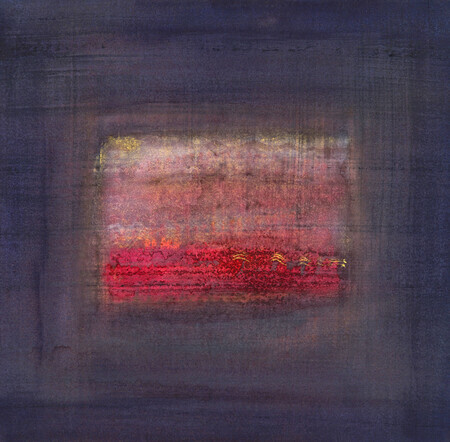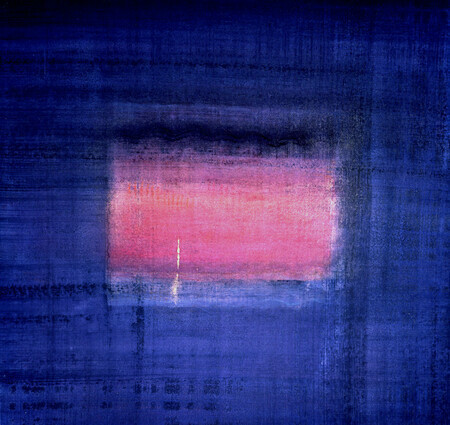| Home | | | Bio | | | Gallery | | | Exhibitions | | | Publications | | | Interview | | | Blog | | | Guestbook | | | Mailing List | | | Links | | | Contact |
Interview by Judith Perry of Artists & Writers
A Vermont-based artist, Sarah Bowen began her art career creating films in collaboration with musicians, dancers, and experimental theaters in the U.S. and Europe. She is the recipient of numerous grants and awards, has held arts residencies at theaters and arts organizations, and is a professor of art and spirituality. Sarah places her work "in the ancient world tradition of sacred art in which the practice of visualization brings about a more evolved and compassionate state of being for artists and viewers alike.”
Sarah and I have been talking about art and following the developments in each other’s work for over ten years. Her paintings have a quiet strength that illuminates the depth of her own thinking about the work. These deeply personal paintings personify, as she says, “the day to day interaction of a meditative life with an engaged studio practice.” The paintings are also nourished by studies in shamanic art, Tibetan Buddhist art, the art of the alchemical tradition, and deep ecology.
Since 1996 Sarah has been working on a series of paintings she calls Inner Landscapes, which are “personal visualizations of wholeness, spiritual connection, and transcendence.”
Perry: Let’s start with a little background — what led to your beginning the Inner Landscapes?
Bowen: My paintings had been representations of actual landscapes, and I was beginning to wonder how to present images of nature that are valid within the present environmental context. How, for instance, do we celebrate landscape in an age when sustainability is stretched so thin? In a landscape painting, do you edit out the power lines that are hanging in front of the view? Do you omit the pieces of styrofoam that are bobbing around at the base of the waterfall?
This inquiry led me to read extensively in deep ecology and ecopsychology, which brought me to some new awarenesses that were critically important for my work. One was the ecopsychological idea that the outer and inner landscapes reflect each other: experiencing the damaged landscape causes us to feel psychologically damaged and depressed, and vice versa: the depression of our inner psyche is mirrored in our collective failure to care for the external landscape. Environmental authors like Theodore Roszak, Joanna Macy, and Thomas Berry have written eloquently about this. Another important awareness that emerged for me was the ancient shamanic idea that all things have soul — not just humans and animals, but also the plants, the rocks, the rivers and oceans, and the air.
At some point I realized — and this was a very deep insight for me — that my real inquiry was not based in the external landscape but in the nature of my own soul, my inner landscape — that consciousness is part of nature as well. In a real sense this involved a huge letting go — letting go of the external landscape as my subject, letting go of my ideas about how my paintings should look, and just letting them come into being, letting them reveal themselves.
Perry: Your realization, that your inquiry was the inner landscape rather than the outer landscape, had to be somewhat life changing, at least in the studio. Letting go of one’s subject could not have been easy. That must have been a rite of passage — What was it like to have to make that decision? It’s probably one of the hardest things one can face in the studio. How did you make that transition?
Bowen: That’s a very insightful question! The shift happened in an organic way, as part of my studio discovery, and it came about through allowing the imagery to be revealed to me. And yet, having experienced that shift, I have realized how right it was, because psychological and spiritual questions are primary for me. And I agree that this was a major “rite of passage,” in the sense that “rite” means “ritual,” and “passage” has to do with a transition in the life of an individual, such as a crisis or a change of status like marriage, illness, or death.
Each individual painting is for me a rite of passage: once the image has fully appeared under my hand and I have really seen it, I am changed; I am not the same as I was before. Reflecting on the imagery brings me to a new place, to a deeper, fuller awareness of what this world is, and what I am within it.
I painted the heart of that very experience in Inner Landscape #11, which is an image of what, for me, being in the center of a rite of passage feels like. The painting represents the liminal or “threshold” stage in the ritual process, where you’re no longer who you were and not yet who you are becoming, but are still in that “betwixt and between” state — a fragile and vulnerable, yet very receptive and magical state of consciousness. I hope that when you look at this painting, you can feel something similar to what I feel. A fleshy, in-the-now feeling, with small glimpses of what is to come.

Inner Landscape #11
Perry: In a sense you are creating images so that they might “speak” to you, help you to learn something. Can you give another example of this?
Bowen: Inner Landscape #8 is a good example. As with many of the Inner Landscape paintings, the central image emerges from a darker surrounding. I associate this with my own practice in life, which is to strive toward coming through a difficult world with integrity, with a sense of wholeness and authenticity, even with happiness. There is an area of heavy darkness just above the central image that feels to me like a kind of depressed feeling, but an acknowledged, even celebrated one. The bright, gold vertical form on the left suggests to me the experience of the “unexpected gift” — it’s not what you expected, and it’s not coming from where you thought it would come, but there it is!

Inner Landscape #8
So, for me, this painting is an image of a state of mind — a state of mind that I’m sure we’ve all experienced at one time or another.
Perry: You are showing us that the making of a work of art is or can be a transformational experience.
Bowen: When we experience struggle in life we have the potential for transformation and growth, and I’ve often had the experience that the creation of the paintings supports my growth in the direction of greater wholeness and integration.
Perry: So the images allow you to “see” yourself in relationship to many things, your life, the world, even your materials. You have the opportunity to experience that idea over and over each day through the practice of making these images. What is your studio process like?
Bowen: While I work on the paintings consciously, with some degree of intent and choice of materials, etc., I also “go with the flow.” In this sense, each image has both conscious and unconscious sources. The final image is really a collaboration, a dance between my conscious self and unconscious input, including the physical input of the paint flow itself.
Perry: It is so interesting that your materials resonate with the deepest themes of your work. You mentioned having learned to allow the paintings to come into being, letting them reveal themselves. Do the materials play a part in this?
Bowen: The materials I use, a combination of oil paint and watercolors, support the fundamental meaning of my work: as the oil and water mediums work against each other, repelling and resisting each other, they symbolize the resistance we all experience as we move through life. This resistance, this life struggle, becomes transformed in these paintings into a rich, luminous, and harmonious whole.
Perry: Your Inner Landscape #12 relates to what we are talking about?
Bowen: The central image in the painting is filled with “musical” detail, which for me expresses the dance of life. The square gold form is approaching, but not at the center — just as we may aim for a centered practice of our own lives, but not quite achieve it. So this image is not about achievement, but about the striving, about the desire for spiritual connection.

Inner Landscape #12
Perry: Tell me how the images are “visualizations of wholeness, spiritual connection, and transcendence.”
Bowen: Underlying this venture is an ancient shamanic idea that the visual image holds transformational power. The psychologist C. G. Jung rediscovered this idea, believing that visual imagery is the language in which the unconscious speaks to our conscious minds. Jung felt that integrating conscious and unconscious ways of knowing in our lives makes us more whole as human beings; this task, which he called “individuation,” is the key task of the second part of life. In similar ways my own studio process has a profound influence on how I conduct my life. My paintings are a form of inquiry for me: they help me to understand who I am and where I hope to go.
Sarah Bowen’s work can be seen at www.sarahbowenart.com and www.vermontartsdirectory.org/directory/listing.php?id=01183.
Judith Perry is an artist and writer based in Maine. Her art can be seen at www.judyperrystudio.com.